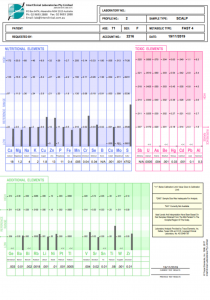
Healthy Ageing: By Meeting Unique Nutritional Needs
Unique Requirements
Each person’s nutritional requirement is unique based on complex factors including current health status and nutritional levels, absorption, exogenous stressors including medication, heavy metal toxicity, physical and emotional stress, etc. Hair Tissue Mineral Analysis empowers practitioners to identify the specific nutrient mineral imbalances and toxic element burdens, thereby enabling treatment on a bio-individual basis.
Distinct mineral patterns can be seen in patients with diseases associated with ageing. Early detection by HTMA of mineral imbalances and heavy metal toxicities, enables practitioners to initiate a preventative care treatment plan which may potentially slow the progression of the disease or reduce symptoms. HTMA is more than an invaluable screening tool, it forms the basis of a treatment plan both in health management and prevention.

Nutrition for an ageing population
The Australian population is ageing, with older Australians a growing proportion of the total population. In 2017, 15% of Australians (3.8 million) were aged 65 and over; this proportion is projected to grow steadily over the coming decades. The focus is not only in relation to healthy ageing but also on creating the need for an evidence-based discipline that aims at improving the health status of the ageing population. Successful ageing is defined by 1. low probability of disease and disease-related disability 2. high cognitive and physical functional capacity and 3. active engagement with life.
It’s presumed that all organ systems of the human body are afflicted by the ageing process. Reduced cerebral function, including dementia or atherosclerosis, is a well-characterized example of the ageing process. Ageing also affects the GI tract, the reduced function of all metabolically active organs that facilitate the uptake, metabolism or excretion of essential nutritional components or foreign substances will have a large effect. Malnutrition is now acknowledged as a problem with the elderly.

The liver volume decreases by 20–40% with age as the result of a decline in liver perfusion. Individuals aged 65 years or older show an approximately 35% decrease in blood volume of the liver compared with the age group below 40 years. Furthermore, the decrease does not only pertain to the total liver volume but also to the mass of functional liver cells which is reflected by an increase in the blood level of cholesterol, high-density lipoprotein cholesterol and neutral fat, whilst the metabolism of low-density lipoprotein cholesterol decreases by 35%. The serum level of bilirubin gradually decreases with age, whilst γ-glutamyltransferase and alkaline phosphatase levels increase.
The volume of the kidneys also decreases with age. The number of glomeruli decreases at a rate of 6752 per year after the age of 18 years. The average kidney mass decreases from >400 g during the 3rd and 4th decade to <300 g by the 9th decade. The age-related morphological changes are accompanied by functional losses: as the glomerular filtration rate and renal plasma flow of the kidney decrease with age, the diluting and concentrating capacities are reduced concomitantly.
The resorptive capacity of the intestine also decreases with age due to reduced enzymatic capacity of the brush border, a reduction in the mucosal surface area in healthy elderly and a reduction in villus height. This age-associated maldigestion is considered one of the factors contributing to malnutrition in the elderly.
Testing for nutrient and toxic elements
InterClinical’s nutrient and toxic element hair testing is a non-invasive pathology that accurately measures tissue mineral levels utilising an ICP Mass Spectrometer. The mineral level is untainted by the body’s immediate reaction to stress, nor the previous meal as opposed to blood minerals which are affected by both and homeostatic regulation. It is the ideal health screening tool for both in-clinic and telehealth consultations.
InterClinical Laboratories HTMA (Hair Tissue Mineral Analysis) test is the gold standard, with quantitative testing of 37 minerals precise to parts per million and the charting of 27 physiologically significant ratios. An Interpretive report including over 4,000 computations, provides a comprehensive patient medical discussion including absolute and relative mineral deficiencies and excesses, toxic burdens, mineral biomarkers, detailed supplement and dietary recommendations aiding the practitioner in determining the best and most appropriate recommendations in therapy and healthcare management.
For more about InterClinical Laboratories HTMA tests, visit here.

No Comments
Sorry, the comment form is closed at this time.